We have given these Class 12 Biology Important Questions Chapter 16 Environmental Issues to solve different types of questions in the exam. Go through these Class 12 Biology Chapter 16 Important Questions, Environmental Issues Important Questions & Previous Year Questions to score good marks in the board examination.
Class 12 Biology Chapter 16 Important Questions Environmental Issues
Question 1.
An electrostatic precipitator in a thermal power plant is not able to generate high voltage of several thousands. Write the ecological implication because of it. (All India 2017)
Answer:
If an electrostatic precipitator is not generating high voltage, it would not be able to release electrons. When air will be passed through this thermal power plant; dust particles would not be able to get collected separately. Hence, it will not be able to control pollution.
Question 2.
Mention two advantages for preferring CNG over diesel as an automobile fuel. (All India 2016, 2015)
Answer:
The two advantages for preferring CNG over diesel as an automobile fuel are as follows
- It bums more effectively leaving no unbumt remains behind.
- It tends to be cheaper than diesel and petrol.
![]()
Question 3.
List two advantages of the use of unleaded petrol in automobiles as fuel. (All India 2015)
Answer:
The two advantages of using unleaded petrol in automobiles as fuel are as follows
- There will be no lead pollution in the environment.
- It allows the use of catalytic converter as the exhaust will not harm the catalyst like leaded petrol.
Question 4.
State the causes of accelerated eutrophication. (Delhi 2014)
Answer:
Effluents from industries and domestic sewage and other human activities are the causes of accelerated eutrophication.
Question 5.
Excessive nutrients in a freshwater body cause fish mortality. Give two reasons. (Delhi 2014C)
Answer:
The reasons for fish mortality in a freshwater body due to excessive nutrients are given below.
- Increase in Biological Oxygen Demand (BOD).
- Eutrophication.
Question 6.
Inspite of being non-polluting, why are there great apprehensions in using nuclear energy for generating electricity? (Foreign 2014)
Answer:
Despite being non-polluting, there are great apprehensions in using nuclear energy for generating electricity because of
- danger of accidental leakage.
- lack of safe disposal methods of radioactive waste.
Question 7.
Write the name of the organism that is referred to as the ‘Terror of Bengal.’ (Delhi 2014)
Or
Why is Eichhornia crassipes nick named as Terror of Bengal? (Delhi 2012)
Or
Name the world’s most problematic aquatic weed. What is the nature of the water body in which the weed grow abundantly? (Delhi 2012C)
Or
Eichhornia crassipes is an alien hydrophyte introduced in India. Mention the problem pased by this plant? (All India 2010C)
Answer:
The name of organism that is referred to as ‘Terror of Bengal’ is Eichhornia crassipes. It is because it grows at an alarming rate and spreads on the surface of the eutrophic water body. It is world’s most problematic weed. This cuts out light and also causes an increase in the oxygen demand. Thus, causing the death of fishes and other aquatic organisms.
Question 8.
Why is the use of unleaded petrol recommended for motor vehicles equipped with catalytic convertors? (All India 2013, 2012 Foreign 2010)
Answer:
Lead found in petrol corrodes the catalytic rods of platinum, rhodium, in catalytic convertor and decreases its efficiency. Thus, unleaded petrol is recommended for motor vehicles equipped with catalytic convertors.
Question 9.
How do algal blooms affect the life in water bodies? (All India 2011)
Answer:
Algal blooms cause deterioration of the water quality. They reduce the dissolved oxygen content of water and cause mortality (death) of aquatic animals like fish. (1)
Question 10.
Mention the information that the health derive by measuring BOD of a water body. (All India 2010)
Answer:
BOD (Biochemical Oxygen Demand) is the amount of the oxygen required by microorganisms to decompose the organic matter present in one litre of water during a particular time period. The higher BOD value indicates high level of pollution. It directly gives an idea of the health of water body. ID
Question 11.
Write the effective remedy found by Ahmed khan of Bengaluru for the efficient use of the plastic waste generated by big cities. (All India 2019)
Or
How did Ahmad Khan, plastic sac manufacturer from Bengaluru, solve the ever-increasing problem of accumulating plastic waste? (All India 2012)
Or
What is polyblend? Why did the plastic manufactures think of producing it? Write its usefulness? (All India 2011)
Answer:
Ahmad Khan developed a fine powder called polyblend of recycled modified plastic. This mixture is mixed with the bitumen and used to lay roads. It enhanced the bitumen’s water repellant properties and helped to increase road life by a factor of three. By this way, the problems created by plastic waste was solved and plastic manufacturers thought of producing polyblend.
Question 12.
How did a citizen group called Friends of Areata Marsh, Areata, California, USA, help to improve water quality of the marsh land using integrated waste water treatment? Explain in four steps. (2018)
Answer:
A citizen group called ‘Friends of Areata Marsh’ used integrated waste water treatment to improve the water quality of the Areata marsh land. This integrated waste water treatment process involved following steps
- The first step involved conventional sedimentation and filtration of water.
- t was followed by addition of chlorine in the water.
- Then, a series of six connected marshes was developed.
- Appropriate plants, algae, fungi and bacteria were seeded in that area to absorb, neutralise and assimilate the pollutants.
Question 13.
Plenty of algal bloom is observed in a pond in your locality.
(i) Write, what has caused this bloom and how does it affect the quality of water.
(ii) Suggest a preventive measure. (Delhi 2017)
Or
What is an ‘algal bloom’? State, its cause and any two harmful effects. (Outside Delhi 2014C)
Answer:
(i) The presence of large amounts of nutrients in water leads to algal bloom.
Algal bloom affects the quality of water in the following ways
- It causes deterioration of water quality making it unfit to use.
- Eutrophication (natural ageing of water bodies) is accelerated, resulting in hypoxic conditions (i.e. low oxygen), killing off the aquatic diversity.
(ii) To prevent the algal bloom, the farmers instead of using chemical nutrients must start using natural products like manures produced using vermicomposting. Awareness should be created among people about the effects of dumping waste in water bodies.
![]()
Question 14.
Public transport in Delhi uses CNG since 2002. List the advantages of this fuel policy. (All India 2015)
Answer:
The advantages of fuel policy involving use of CNG in public transport in Delhi are
(i) CNG, i.e. compressed natural gas is a better fuel than petrol or diesel, because it is cheaper, burns more effeciently, does not pollute the environment.
(ii) It cannot be siphoned off by thieves. In addition to this, it cannot be adulterated like petrol and diesel.
Question 15.
Name two metals used in a catalytic convertor. How do they help in keeping the environment clean? (Delhi 2014C)
Or
State the function of a catalytic convertor in an automobile. (All India 2011C)
Answer:
The metals used in a catalytic convertor are platinum, palladium and rhodium (any two).
The catalytic convertors fitted in automobiles reduce the emission of poisonous gases by converting the unbumt hydrocarbons into CO
2
and water, carbon monoxide to CO
2
and nitric oxide (NO) to nitrogen, while the exhaust is passed through them.
Question 16.
‘Fish mortality increases with influx of nutrients in a freshwater body’. Write two reasons. How will the influx of nutrients affect the BOD level of this water body? (All India 2014C)
Or
Write the harmful effects of the presence of large amount of nutrients in a water body. (Delhi 2012C)
Answer:
Fish mortality increases with influx of nutrients in a freshwater body, because
- Abundant nutrients encourage the growth of free-floating algae and plants, thereby increasing organic matter.
- The influx of nutrients increases the BOD level of water body, as the microbes flourishing in it consume up all the oxygen in degrading the organic matter. As the BOD increases, the Dissolved Oxygen (DO) decreases, making the water body unfit for aquatic life.
Question 17.
Explain, how does the inflow of large amount of nutrients like phosphates and nitrates into the water body drastically affects the aquatic life there? Name the phenomenon responsible. (Delhi 2014C)
Answer:
The inflow of large amount of nutrients like nitrates and phosphates initially encourages growth of aquatic organisms, plants and animals. With time as the organic matter increases, debris along with silt piles up at bottom making the water body shallower and warmer.
This leads to gradual appearance of floating and marshy plants and is eventually converted into land. Hence, the aquatic life gets severely affected and disrupted. This phenomenon is called eutrophication. It may be natural or artificial due to result of human activities.
Question 18.
BOD was measured in two different places A and B of a river in the direction of its flow. BOD value was higher at A than at B. What do you infer from this observation and why? (All India 2013C)
Answer:
Higher BOD in river A indicates the discharge of domestic waste is done near A. The organic matter increases the BOD as decomposers need oxygen for the microbial activity. As sewage is decomposed towards B, then there is gradual rise in the dissolved oxygen. Reappearance of fishes and other clean water organisms is indicating recovery of river from sewage pollution.
Question 19.
Name any two sources of e-waste and write two different ways for the disposal. (Delhi 2013)
Or
Mention how e-waste is produced and disposed off ? Write the solution for its treatment? (All India 2010)
Answer:
Electronic wastes (e-wastes) are generated from electronic appliances. It includes broken mobile phones, televisions, irreparable computers, etc. The sources of e-waste come from a vast area of our daily life as each and every field is dependant in electronic appliances. Incineration and land filling are two ways of e-waste disposal. Recycling is the solution for the treatment.
Question 20.
Explain, biomagnification of DDT in an aquatic food chain. How does it affect the bird population? (Outside Delhi 2012)
Answer:
There can be up to 1000 times increase in concentration of DDT in phytoplankton as compared to water, in zooplankton as compared to phytoplankton, in different fish as compared to zooplankton and more DDT in fish eating birds as compared to fish. This continuous increase of DDT concentration is called biomagnification. Higher amounts of pesticide disturb calcium metabolism of birds resulting in thinning of egg shells and their premature breaking that kills the embryos. Thus, causing decline in the bird population.
Question 21.
Explain, how does the algal bloom eventually choke the water body in an industrial area? (Delhi 2012)
Answer:
The nutrient enrichment of water bodies near industrial area is due to the passage of industrial effluents sewage, etc. This causes increased growth of planktonic algae that causes colouration of water called algal bloom. Excessive growth of algae cut off light for submerged plants which kills the latter and causes organic loading. This leads to decreased oxygen level and pilling of aquatic animals and plants which eventually chokes the water body.
Question 22.
Study the graph given below. Explain, how is oxygen concentration affected in the river when sewage is discharged into it.
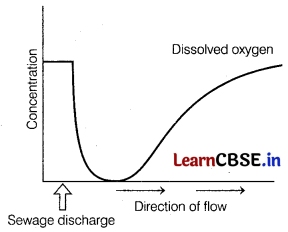
Answer:
When sewage containing organic waste is discharged into the river, the microorganisms consume a large amount of O
2
for degrading organic matter. This causes decline in O
2
content in water downstream from the point of sewage discharge. After a short distance, there is a gradual rise in dissolved oxygen downstream because of reduced BOD.
Question 23.
Why is it difficult to get rid of ‘water hyacinth’ from a water body? Name one abiotic component and one biotic component of the ecosystem that get affected by its spread in the water body. (Delhi 2011C)
Answer:
The eutrophic bodies support excessive growth of water hyacinth (Terror of Bengal), therefore, it is very difficult to get rid of it and hence, known as an aquatic weed. Abiotic and biotic components affected by the growth of water hyacinth are light and the growth of the submerged plants respectively.
![]()
Question 24.
Study the graph given below. Explain, how oxygen concentration is affected in the river, when sewage is discharged into it? (Delhi 2011)
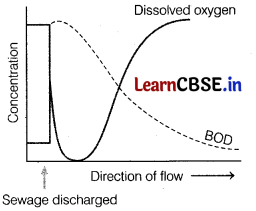
Answer:
The graph shows the decrease in dissolved oxygen due to sewage decomposition. When sewage is discharged into river, microorganisms present in water help in biodegradation of organic matter. They consume a lot of oxygen. Therefore, there is a sharp decline in dissolved oxygen. When the sewage is completely degraded, oxygen concentration again increases.
Question 25.
How does an Electrostatic Precipitator (ESP) work to remove particulate pollutants released from the thermal power plants? (Delhi 2010)
Answer:
Electrostatic Precipitator (ESP) has electrode wires and a stage of collecting plates. Wires are provided with an electric current of several thousands volts, which produces a corona that releases electrons.
These electrons attach to dust particles, giving them a negative charge within a very small fraction of a second. Collecting plates are earthed, so that they attract charged dust particles. The velocity of air passing through plates is slow enough to allow the dust particles released from thermal power plants to fall on them.
Question 26.
Mention the major causes of air pollution in metro cities. Write any three ways, which it can be reduced. (All India 2010)
Answer:
Major causes of air pollution are
- Smoke from thermal power plants, forest fires, volcanic eruptions.
- Use of unleaded petrol.
- Excessive use of fossil fuels by automobiles and industries releasing particulate and air pollutants.
Three control methods for air pollution include
- Using electrostatic precipitators to remove particulate matter from exhaust of industries and thermal power plant.
- Using scrubber to remove gases like S02.
- Use of catalytic convertors in automobiles for reducing emission of poisonous gases.
Question 27.
Study the given aquatic food chain. Answer the questions that follow
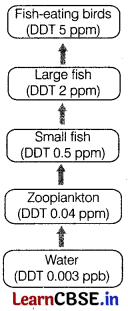
(i) Give reason, why there is a continuous increase in the DDT content in different trophic levels of the chain?
(ii) Name the phenomenon responsible for the increase in DDT content. (Delhi 2010)
Answer:
(i) Continuous increase in the DDT concentration is because of following reasons
- It cannot be metabolised.
- It is not excreted, but it is passed on to next higher tropic levels.
(ii) Biomagnification is the phenomenon responsible for increase in the DDT content.
Question 28.
Explain giving reasons the causes of appearance of peaks A and B in the graph shown below. (All India 2010)
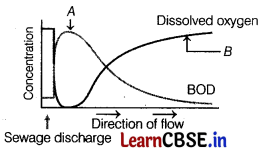
Answer:
A – High BOD due to sewage discharge.
B – Increase in dissolved oxygen due to sewage decomposition.
Microorganisms involved in biodegradation of organic matter consume a lot of oxygen.
Therefore, there is a sharp decline in dissolved oxygen. When the sewage is completely degraded, oxygen concentration again increases.
Question 29.
While on a visit to a pond in the city-neighbourhood, the visitors were delighted to find large expanse of water covered with colourful algal mass.
(i) As a student of biology do you agree with their delight? Give reasons in support of your answer.
(ii) Explain the cause of such algal growth. (Delhi 2019)
Answer:
(i) As a student of biology, I do not agree with the delight of visitors. Large expanse of water covered with colourful algal mass represents excessive growth of algae in pond. This excessive growth is called algal bloom. Because algal bloom deteriorates water quality and causes fish mortality in the water body, it is not possible to agree with the delight of visitors.
(ii) The presence of large amounts of nutrients in water leads to algal bloom. These nutrients (nitrogen and phosphorus) are added to waterbodies from fertilisers that get dissolved in soil and are washed off by waterbodies. Excessive growth of phyptoplankton occurs due to the presence of large amounts of nutrients in water.
Question 30.
Explain the effect on the characteristics of a river when urban sewage is discharged into it. (2018)
Or
Explain the changes that can be observed in the characteristics of river water when sewage is discharged into it and a few weeks after the discharge with respect to
(i) Level of dissolved oxygen.
(ii) Population of freshwater organisms. (Delhi 2015C)
Answer:
(i) Discharge of domestic sewage into a river water results in the rise of BOD, because decomposers consume a lot of oxygen. If sewage quantity is large, then the dissolved oxygen will be completely consumed thus leaving nothing for aquatic organisms present in water body. However, as sewage is decomposed, there will be gradual rise in dissolved oxygen downstream.
(ii) With depletion in level of dissolved oxygen, population of freshwater organisms (plants and animals) would decline. But, as levels of dissolved ‘oxygen would increase, fish and other aquatic organisms reappear indicating the recovery of river from sewage pollution.
The effect on the characteristics of a river when urban sewage is discharged into it can be plotted on graph as shown below.
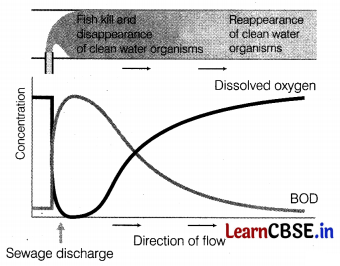
Question 31.
(i) Name any two places where it is essential to install electrostatic precipitators. Why is it required to do so?
(ii) Mention one limitation of the electrostatic precipitator. (Delhi 2016)
Answer:
(i) Electrostatic precipitators are needed to be installed in thermal power plant and industries. It is the most widely used method for controlling the air pollution or removing particulate matter. In this process, small particles present in dirty air are first charged electrically and then allowed to settle down over differently charged collecting plates. This method allows smaller particles to be removed from the emissions.
(ii) Limitation of using electrostatic precipitator is that it only works on gravitational settling method. Velocity of air between the plates is maintained low to allow the dust to fall in.
Question 32.
Our farmers still use DDT. How is this affecting the local bird population? (Delhi 2015C)
Answer:
Our farmers still use DDT and which is well-known cause for biological magnification. Due to the excessive use of DDT, calcium metabolism in birds is disturbed, which results in thinning of egg shell. Due to this, premature breaking of eggs occurs and leads to decline in birds population. If DDT leaches from the agricultural field, it gets into the water body (the concentration is 0.003 ppb) and enters the food chain : Zooplanktons (0.04 ppm)- Small fish (0.5 ppm)-Large fish (2 ppm)-Any fish eating birds (5 ppm). Concentration of DDT increases along the food chain, reaching a high level in the top carnivore bird.
![]()
Question 33.
With the help of a flow-chart exhibit the events of eutrophication. (Outside Delhi 2015)
Answer:
Eutrophication is the natural ageing of the water. The flow chart exhibiting the events of eutrophication in lake is given below
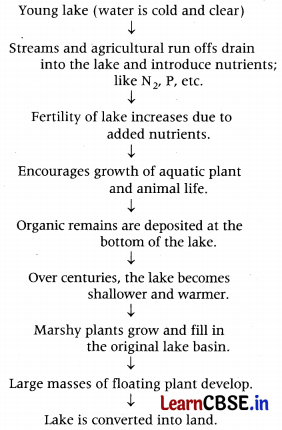
Question 34.
With the help of a flowchart, show the phenomenon of biomagnification of DDT in an aquatic food chain. (All India 2015)
Or
Explain biomagnification. How does the biomagnification of DDT affect the population of fish eating birds? (Foreign 2010)
Or
Why is there a decline in the population of the fish eating birds, when the water body is amidst agricultural fields? (Delhi 2010c)
Answer:
Biological magnification (Biomagnification) can be defined as the increase in concentration of toxicants at successive trophic levels, e.g. DDT. This is because these toxicants cannot be metabolised or excreted. Therefore, it gets accumulated in an organism and pass on to higher trophic levels.
DDT accumulates in the fish eating birds and disturbs calcium metabolism, which results in thinning of egg shell. This results in decline in the population of the fish eating birds.
Biological magnification of DDT is shown in the flowchart below
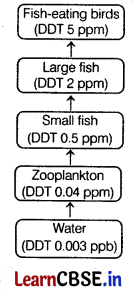
Question 35.
Drinking water problem in our urban areas is caused mainly because, we fail to protect our water bodies. Explain, how accelerated eutrophication chokes our water bodies to death? (outside Delhi 2015C)
Answer:
The accelerated eutrophication is the nutrient enrichment of water bodies due to human activities like passage of sewage, industrial effluents, domestic wastes and agricultural run offs rich in nitrates and phosphates.
The lake’s fertility increases due to these nutrients leading to dense growth of plants and the planktonic algae, i.e. algal bloom.
Algal blooms and floating plants cut off light for submerged plants due to which the latter die. There is drastic decrease in oxygen replenishment inside water. It causes organic loading of water. Decreased oxygen level also kills aquatic animals, further adding to organic loading. Decomposition is replaced by putrefaction which is anaerobic.
It produces secondary pollutants that kill the bloom promoting plants as well and thus choking water bodies to death. (3)
Question 36.
Two types of aquatic organisms in a lake show specific growth patterns as shown below, in a brief period of time. The lake is adjacent to an agricultural land extensively supplied with fertilisers.
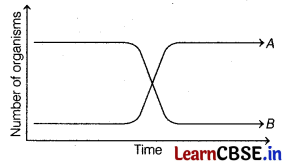
Answer the questions based on the facts given above
(i) Name the organisms depicting the patterns A and B.
(ii) State the reason for the growth pattern seen in A.
(iii) Write the effects of the growth patterns seen above. (All India 2014)
Answer:
(i) The organisms depicting pattern A are
microorganisms, while B depicts- zooplanktons or fishes.
(ii) With the increase in organic matter of lake due to influx of nutrients from agricultural land, the number of microorganisms increases which degrade the organic matter.
(iii) From the above growth patterns, it can be concluded that
- with the increase in microbes in water b’ody the BOD increases, making it unfit for aquatic life.
- dissolved oxygen reduces drastically leading to mortality of aquatic organisms, i.e. fishes.
Question 37.
A few residents in your locality, for business gains, have established small scale indsutrial/commercial activities such as pathological labs and fabric dyeing centres without obtaining ‘No objection certificates’ from municipal authorities. Would you support these activities? Give any three reasons in support of your answer. (All India 2014C)
Answer:
No, these activities would not be supported, because
- The industrial/commercial activities will release its toxic gases into the atmosphere and other chemicals into the nearby water bodies without treating it and thus, cause pollution of air, water and soil.
- The land acquired for operating these activities should be at a location where people or neighbourhood are leasi affected, so prior permission is mandatory.
- Disposable waste of pathological labs can be infectious and toxic, including the same from other industries, so it is necessary to keep a check on how the wastes are disposed off, segregated and recycled by these industries.
Question 38.
Why should the spraying of DDT as an insecticide on vegetable crops be banned? Explain. (Delhi 2013C)
Answer:
Spraying of DDT as an insecticide on vegetable crops should be banned, because our food grains such as wheat, rice, fruits and vegetables accumulate the varying amount of insecticide residues and that enter the human body through food chain. As these chemicals are toxic and non-biodegradable, they get accumulated in organism’s body and are difficult to excrete and their concentration keeps on increasing at successive trophic levels. The organisms, thus present at highest level are severely affected.
Question 39.
How does algal bloom destroy the quality of a freshwater body? Explain. (Delhi 2013)
Or
How does an algal bloom cause eutrophication of a water body? Name the weed that can grow in such a eutrophic lake. (Delhi 2012)
Answer:
Algal bloom destroy the quality of freshwater body and causes eutrophication because run off of nutrients such as animal wastes, fertilisers (N and P) and sewage from land leads to an increase in the fertility of the lake.
It causes a tremendous increase in the primary productivity of the water body leading to increased growth of algae, resulting into algal bloom. Later, the decomposition of these algae depletes the supply of oxygen, leading to the death of other aquatic animal life. This leads to eutrophication of fresh water body and destroys its quality.
Eichhomia crassipes (water hyacinth) also called ‘Terror of Bengal’, as it grows abundantly in such eutrophic lake.
Question 40.
By the end of 2002, the public transport of Delhi switched over to a new fuel. Name the fuel. Why is this fuel considered better? Explain. (Delhi 2012)
Answer:
Delhi had been categorised as the fourth most polluted city of the world in a list of 41 cities in the 1990s. Vehicular pollution has added to the pollution of air in Delhi.
So, in the year 2002, it switched over to a new fuel CNG (Compressed Natural Gas).
Reasons of CNG being considered better fuel, Refer to Answer No. 14.
![]()
Question 41.
(i) Why are colourful polystyrene and plastic packaging used for protecting the food, considered an environmental menace?
(ii) Write about the remedy found for the efficient use of plastic wastes by Ahmad Khan of Bengaluru. (Delhi 2012)
Answer:
(i) Because polysterene and plastic are non-biodegradable, they accumulate and add to environmental pollution hence, are considered a menace.
(ii) For remedy for the efficient use of plastic wastes by Ahmad Khan, Refer to Answer No. 11.
Question 42.
(i) State the consequence if the electrostatic precipitator of a thermal plant fails to function.
(ii) Mention any four methods by which the vehicular air pollution can be controlled. (All India 2011)
Answer:
(i) In the absence of Electrostatic Precipitator (ESP) the particulate pollutants and gaseous pollutants of the exhaust will enter into atmosphere. In case of ESPs, about 99% of particulate matter is absorbed.
(ii) General steps to reduce vehicular air pollution are
- Phasing out of old vehicles.
- Use of unleaded petrol and low sulphur petroband diesel.
- Use of catalytic convertors in vehicles.
- Application of pollution control norms for vehicles.
Question 43.
Eutrophication is the natural ageing of a lake. Explain. (Foreign 2011)
Or
How does eutrophication in a lake take place? Explain. (Delhi 2011C)
Answer:
The natural ageing of a lake is called eutrophication. In a young lake, there is very little life. Over the time, streams drain into it and water becomes enriched with nutrients like phosphate and nitrates.
As a result, phytoplanktons and some other plants flourish well in this water. Due to this, the organic matter increases in lake, water becomes warmer and shallower and decomposers also start growing.
The high number of decomposers make use of large quantity of oxygen for decomposition. This leads to depletion of dissolved oxygen of the water and mortality of fish and other aquatic organisms.
The eutrophied water bodies can lead to algal blooms, which further add organic matter in lake. These consume more oxygen leading to its depletion. Finally the water bodies gets converted to land.
Question 44.
Biomagnification and accelerated eutrophication are both caused due to indiscriminate use of chemicals and irresponsible human activities. Do you agree? Support your answer with explanation and an example of each. (All India 2019)
Answer:
I agree that biomagnification and accelerated eutrophication are both caused due to the indiscriminate uses of chemicals and irresponsible human activities. For explanation and example of each, Refer to Answer No. 34 and 35, respectively.
Question 45.
(i) Why are catalytic convertors recommended for vehicles?
(ii) Why should such vehicles use only unleaded petrol?
(iii) Why is CNG preferred to diesel as a fuel in vehicles? (Delhi 2010C)
Answer:
(i) For catalytic converters in vehicles, Refer to Answer No. 15.
(ii) Such vehicles (with catalytic convertor) should use unleaded petrol as leaded petrol inactivates the catalyst.
(iii) For preference of CNG as a fuel in vehicles. Refer to Answer No. 14.
Question 46.
Name the layer of the atmosphere that is associated with good ozone. (Delhi 2019)
Answer:
Good ozone is found in stratosphere, which is formed by UV radiations and oxygen molecules. This type of ozone is beneficial for living organisms.
Question 47.
Name the greenhouse gases that contribute to global warming. (Delhi 2014)
Answer:
The greenhouse gases that contribute to global warming are CO
2
, CH
4
, N
2
O and CFCs.
Question 48.
State the purpose of signing the Montreal Protocol. (Foreign 2014)
Answer:
The purpose of signing the Montreal Protocol is to control the emission of ozone depleting substances.
Question 49.
Where is good ozone present? Why is it called SO? (All India 2014C)
Answer:
Good ozone is present in stratosphere (i.e. the upper part of atmosphere).
It is called ‘good ozone’, because it acts as a shield for absorbing ultraviolet radiations from the sun.
Question 50.
Name the two gases contributing maximum to the greenhouse effect. (Delhi 2014C)
Answer:
The two gases contributing maximum to greenhouse effect are CO
2
and CH
4
.
Question 51.
Mention two harmful effects of UV-B exposure on human eye. (Delhi 2012)
Answer:
UV-B exposure on human eye causes inflammation of cornea and cataract.
Question 52.
Write the unit used for measuring ozone thickness. (Delhi 2011)
Answer:
Dobson Unit (DU) is used for measuring ozone thickness.
Question 53.
How does Jhum cultivation promote deforestation? (All India 20110)
Answer:
In Jhum cultivation, the farmers cut down the trees of forest and land is used for farming. After cultivation, the area is left free for several years for recovery. The recovery phase is often ignored leading to deforestation.
Question 54.
How is snow blindness caused in humans? (All India 2010)
Answer:
Snow blindness is caused by the absorption of UV-B radiation.
![]()
Question 55.
Name two greenhouse gases produced by anaerobic microbes. (Foreign 2010)
Answer:
Carbon dioxide and methane are the greenhouse gases produced by anaerobic microbes.
Question 56.
Mention the causes of thinning of ozone layer. (Delhi 2010c)
Answer:
CFCs release chlorine atoms, when UV-rays act on them. Chlorine degrades the ozone into molecular oxygen. Thus, causing thinning of ozone layer.
Question 57.
Justify the need for signing of ‘Montreal Protocol’ by the participating nations in 1987. (All India 2019)
Answer:
Montreal Protocol was signed at Montreal (Canada) in 1987 (effective in 1989) to control the emission of ozone depleting substances like CFCs and aerosols. The balance of ozone production and degradation has been disrupted due to enhancement of ozone degradation by Chlorofluorocarbons (CFCs). Once CFCs are added to the stratosphere, they have permanent and continuous effects on ozone levels.
Question 58.
List four benefits to human life by eliminating the use of CFCs. (All India 2017)
Answer:
Benefits of eliminating CFCs from human life are as follows
- Prevention of global warming.
- Reduction in ozone degradation.
- Reduction in greenhouse effect,
- Beneficial for human health.
Question 59.
Explain the relationship between CFC and ozone in the atmosphere. (All India 2016)
Answer:
The chlorofluorocarbon releases active chlorine (Cl, CIO). This active chlorine gets perched over atmospheric ice crystals and remains functional for a long time. A single chlorine atom converts 1 lakh molecules of ozone into O
2
.
Question 60.
What is joint forest management? How can it help in conservation of forest? (Foreign 2015)
Answer:
The concept of Joint Forest Management (JFM) was introduced by the Government of India. In this programme, support of local communities was taken for conservation of forests and in return, the local people were made to use the products obtained from the forest free of cost. In this programme, local people protect forest, which helps in conservation of forest and its biodiversity.
Question 61.
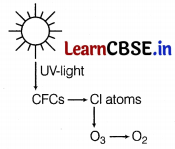
(i) What are the after effects of the degradation of ozone?
(ii) How does it affect human health? (Delhi 2015C)
Answer:
(i) The degradation of ozone will lead to higher mortality of young ones of animals, high number of mutations, inhibition of photosynthesis, global warming and disturbance in aquatic and terrestrial food chains.
(ii) Ozone degradation allows the harmful UV-B exposure on human eyes that causes imflammation of cornea and cataract. It also causes various types of skin cancer.
Question 62.
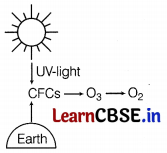
(i) Expand CFC.
(ii) How does it reduce ozone to oxygen? (All India 2015C)
Answer:
(i) CFC-Chlorofluorocarbon
(ii) For reduction of ozone to oxygen. Refer to Answer No. 14.
Question 63.
Write, what was the percentage of forest cover of India at the beginning and at the end of 20th century? How different is it from the one recommended by National Forest Policy? (Foreign 2014)
Answer:
In the beginning of the 20th century, the forest cover was about 30%, while towards its end it is cover for hilly regions including Himalayas, while 33% for plains. However, the situation is contrastingly different as the production of forests in India is very slow.
Question 64.
(i) State the cause of depletion of ozone layer.
(ii) Specify any two ill effects that it can cause in the human body. (Foreign 2014)
Answer:
(i) The main cause of depletion of ozone layer is imbalance between production and degradation of ozone in the stratosphere. This balance is disrupted mainly due to increase in ozone degradation by CFCs.
(ii) The ill effects that ozone depletion can cause in human body are
(a) Allows UV-B radiation to enter atmosphere that increases mutation and damages DNA.
(b) Causes ageing of skin and damage to skin cells and cancer.
(c) Inflammation of cornea (snow blindness), cataract, etc.
Question 65.
Refrigerants are considered to be a necessity in modern living, but are said to he responsible for ozone holes detected in Antarctica. Justify. (Foreign 2012)
Or
Chlorofluorocarbons (CFCs) are widely used as refrigerants. Then why is it suggested to reduce its emission as far as possible? Explain. (Delhi 2010)
Answer:
Refrigerants contain CFCs, which are released in the lower part of the atmosphere. Their emissions into the atmosphere is suggested to be reduced because:
- They move upwards and reach the stratosphere.
- In stratosphere, UV-rays act on them releasing Cl atoms. Cl degrades ozone and releases molecular oxygen.
- Cl atoms act only as catalysts, the CFCs have a permanent damaging effect on ozone.
![]()
Question 66.
The figure given below shows the relative contribution of four greenhouse gases to global warming.

(i) Identify the gases A and C.
(ii) Why are these four gases called greenhouse gases? (Foreign 2011)
Answer:
(i) A – Carbon dioxide (CO
2
)
C – Chlorofluorocarbons (CFCs)
(ii) These four gases (CO 2 , CH 4 , N 2 O) and CFCs) are called greenhouse gases, as they absorb infrared radiations emitted by the earth’s surface and cause greenhouse effect, i.e. heating of earth’s surface and atmosphere.
Question 67.
Enumerate the consequences of deforestation. (All India 2012C)
Answer:
The consequences of deforestation are as follows
- Deforestation leads to reduced rainfall, increased drought, hotter summer and colder winters.
- It also leads to soil erosion.
- Deforestation increases atmospheric CO 2 content by releasing carbon stored in organic matter and reduced primary activity.
Question 68.
(i) Why and how must the ozone layer in the stratosphere be protected? Explain.
(ii) How do deforestation and greenhouse gases negatively affect our environment? Explain. (All India 2019)
Answer:
(i) The ozone layer in the stratosphere must be protected, because the ozone in the stratosphere is good ozone that acts as a shield and absorbs ultraviolet radiations from the sun. UV rays are extremely harmful to living organisms.
Ozone gas is continuously formed by the action of UV rays on molecular oxygen and also degraded into molecular oxygen in the stratosphere. In order to protect the ozone layer, there should be a balance between production and degradation of ozone in the stratosphere.
In the recent years, the balance has been disrupted due to enhancement of ozone degradation by chlorofluor carbons (CFCs). So the emission of ozone degrading substances like CFCs need to be controlled to protect the ozone layer in stractosphere.
(ii) For effects of deforestation. Refer to text on page no. 405-406.
Effects of Greenhouse Gases
(i) Greenhouse gases include CO
2
, CFCs, etc. Their high level in the atmosphere allow the heat waves to reach earth, but prevent their escape and earth becomes warm. This increased temperature in last three ecades had caused changes in precipitation patterns.
(ii) The increased temperature also cause EL-nino effect, melting of the polar ice caps and Himalayan snow.
Question 69.
(i) Why is the ozone layer required in the stratosphere? How does it get degraded? Explain.
(ii) Why is the ozone depletion a threat to mankind? (Delhi 2013C)
Answer:
(i) Ozone found in stratosphere is required because it acts as a shield absorbing harmful ultraviolet radiations coming from the sun.
Ozone layer gets depleted by the ozone depleting compounds mainly Chlorofluorocarbons (CFCs), which travel to the stratosphere after being released from the refrigerants and industrial emissions. UV-rays from the sun acts on CFCs releasing atoms, which degrade ozone releasing molecular oxygen.
(ii) The ozone depletion in a threat to mankind due to ill effects that ozone deplation can cause in human body. For ill effects of ozone depletion in human body, Refer to Answer No. 19 (ii).
Question 70.
Mohit while buying a car insisted on CNG with better mileage whereas Anil leaned towards diesel version of a high end car with relatively low mileage.
What qualities are being displayed by Mohit’s behaviour? Mention any two reasons behind Mohit’s decision.
Answer:
Mohit displays concern towards his environment and responsibility.
- CNG burns efficiently wihout leaving residues.
- CNG is cheaper.
Question 71.
Looking at the deteriorating air quality because of air pollution in many cities of the country, the citizens are very much worried and concerned about their health. The doctors have declared health emergency in the cities where the air quality is very severely poor.
(i) Mention any two major causes of air pollution.
(ii) Write any two harmful effects of air pollution to plants and humans.
(iii) As a captain of your school Eco-club, suggest any two programmes you would plan to organise in the school, so, as to bring awareness among the students on how to check air pollution in and around the school. (2018)
Answer:
(i) The two major causes of air pollution are:
- Particulate matter released from thermal power plants and other industries.
- Poisonous gases (e.g. CO 2 ,CO, NO 2 ) released from automobiles.
(ii) Effect on plants Reduces growth and yield of crops and causes premature death of plants. Effects on humans Irritation and inflammation of the lungs and premature deaths.
(iii) As a captain of my school Eco-club, I will suggest following two programmes to bring awareness among students on how to check air pollution.
- Organisation of ‘Van-Mahotsava’ programme in my school campus. In this progamme, there would be lectures on cures of air pollution and how planting trees can help against it. Plants will also be planted in school campus.
- By organising a debate on ‘air pollution and its causes.’In this programme, students who have given their any contribution in controlling air pollution will be rewarded.
Question 72.
A national newspaper reported that a 50 metre high ‘Sanitary landfill’ the dumping site of city’s garbage in one of the metro-cities crashed and caused heavy damage and disaster in and around the area. A couple of cars, two-wheelers and cattle were swept away in the nearby overflowing canal. Three persons including a young girl were crushed under the garbage and died.
(i) Write any two points that in your opinion could have caused this landfill crash.
(ii) Mention any four preventive measures to be adhered to as a policy which could have avoided this accident.
(iii) Write any two suggestions that you would like to give to the citizens, so as to help in preventing such a disaster in future. (2018C)
Answer:
(i) Two points that in my opinion could have caused landfills crash are
- Increase in weight of garbage due to overloading of landfill.
- Poor monitaring and management of landfill area.
(ii) Four preventive measures to be adhered as policy are
- Prevent overloading of landfill area.
- Garbage dumped should be compacted regularly.
- Engineers to design landfills.
- Regular monitoring of landfill area.
(iii) TWo suggestions to citizens so as to help them in preventing such disaster in future are
- Citizens should recycle the waste as much as possible.
- Citizens should avoid creating trash.
![]()
Question 73.
Public all over India is very much concerned about the deteriorating air quality in large parts of North India. Alarmed by this situation the Resident’s Welfare Association of your locality organised an awareness programme entitled ‘Bury Not Bum’. They invited you, being a biology student to participate.
(i) How would you justify your arguments that promote burying and discourage burning? (Give two reasons)
(ii) With the help of flow charts, one for each practice, depict the chain of events that follow. Delhi 2017
Answer:
(i) Following arguments can be put forward to promote burying and discourage burning
- When we bum wastes, pollutants such as carbon dioxide, carbon monoxide, etc., are released in the atmosphere. These pollutants damage the environment. Due to burning, smoke is released into atmosphere, which causes problems; like asthma, emphysema, etc.
- Burying the waste does not have any harmful effect. In fact, when we bury organic wastes, the soil becomes enriched with nutrients.
(ii) The solid wastes are of two types
- Biodegradable wastes These can be degraded by the microbes, e.g. organic wastes, paper, etc.
- Non-biodegradable wastes These cannot be degraded by the microbes and can remain as such for long periods, e.g. plastic.
Flow charts depicting effects of burying and burning are as follows
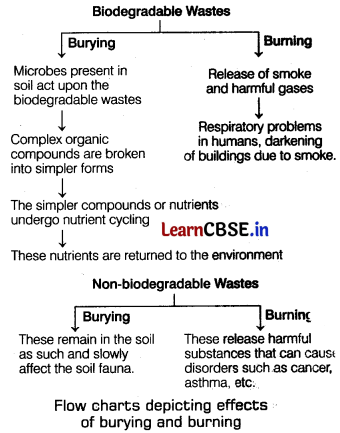
Question 74.
Since 2nd October, 2014 ‘Swachh Bharat Abhiyan’ has been launched in our country.
(i) Write your views on this initiative giving justification.
(ii) As a biologist name two problems that you may face while implementing the programme in your locality.
(iii) Suggest two remedial methods to overcome these problems. Delhi 2015
Answer:
(i) Mahatma Gandhi said, ‘Sanitation is more important than independence’ and it is so true, when the present situtation of our country is seen. In our country, more than 72% of mral population lacks adequate sanitation facilities while 55% of population has no access to basic amenities like toilets in various cities of India.
I am completely in support of Swachh Bharat Abhiyan. It is our primary duty to keep our nation clean, because wastes are the biggest evil that hinder the progress and the development of a country. An unclean environment leads to a lot of problems, starting from affecting the health of citizens to the shortage of land.
On a large scale, it is responsible for the pollution, be it air and water, which creates problems both on development and economic fronts of the country.
(ii) (a) It is very difficult to change the mind set of people, not to spit on roads, staircase, etc.
(b) Many people living even in good societies do have habit of keeping their garbage in open areas, which get spilled by animals (dogs, cats), thus polluting the colony.
(iii) These problems can be overcome by implementing following strict measures
- A committee of few members can be established and whenever anyone spitting, throwing garbage on roads or urinating in open is spotted should be punished.
- We should keep sweepers on monthly wages for regular cleaning of roads.
- Separate dustbins (like blue, red, green) for specific waste disposal, i.e. biodegradable and non-biodegradable.
Question 75.
Presently, air quality of Delhi has significantly improved in comparison to what existed before 1997.
This is the result of a lot of conscious human efforts. You are being asked to conduct an awareness programme in your locality wherein you will comment on the steps taken by the Delhi Government to improve the air quality.
(i) Write any two of your comments.
(ii) List any two ways that you would include in your programme so as to ensure the maintenance of good quality of air.
(iii) State any two values your programme will inculcate in the people of your locality. Foreign 2014
Answer:
(i) The comments on the steps taken by Delhi Government to improve air quality are
- Switching over of the entire public transport from diesel or petrol to CNG.
- Use of unleaded and low-sulphur petrol by vehicles.
(ii) The other two ways that can be included in the programme, so as to ensure maintenance of good quality of air can be
- Create awareness among people to switch over to CNG as it is less polluting as well as cost effective and phasing out of old vehicles.
- Follow the routine pollution check according to pollution-level norms for vehicles and use catalytic convertors.
(iii) The programme can inculcate following values
- The people will become more responsible and guard their contributions towards air pollution.
- After knowing the hazards and various consequences of pollutants, they will not indulge in activities especially unauthorised and without having permission and will prevent others from doing so.